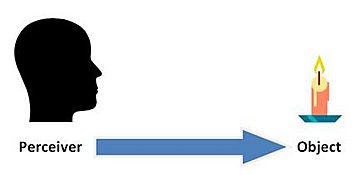Naïve realism facts for kids
Naïve realism (also called direct realism or common sense realism) is a way of thinking about how we see the world. It's the idea that our senses, like sight, hearing, and touch, show us things exactly as they are. When you look at an apple, a naïve realist believes you are directly seeing the real apple. You are not seeing a copy or a picture of it in your mind.
This idea means that the objects we see are not just "representations" in our brains. They are the actual objects themselves. A naïve realist also usually believes that these objects exist even when no one is looking at them. They follow the rules of physics. They have properties like size, shape, color, and texture. And we usually see these properties correctly.
Naïve realism is different from other ideas. For example, indirect realism suggests that our senses give us a mental picture of the world. This picture is based on what our senses pick up. It's not the world itself. Naïve realism also differs from idealism. Idealism claims that nothing exists outside of our thoughts and ideas. It is also different from philosophical skepticism. This idea suggests we cannot truly trust our senses. It questions if we can ever know the real world.
What is Naïve Realism?
Naïve realism is based on a few main ideas:
- The world is real: There are real objects made of matter. They exist whether we see them or not. These objects have properties like shape, size, and color. They have these properties even if no one is there to observe them.
- We learn from our senses: We can learn true things about these objects. We do this by using our senses. Our experiences help us understand the world.
- We see things directly: We see the world directly through our senses. We see it pretty much as it truly is. This means we can trust what our senses tell us. We can gain real knowledge about the world.
Many modern thinkers support direct realism. These include philosophers like Hilary Putnam and John R. Searle. Searle argues against the common idea that we only see our own experiences. He believes we can directly see objects in the world. He says that arguments against direct realism are often based on weak ideas.
For example, when you watch a sunset, a direct realist believes you are seeing the actual sunset. An indirect realist might say you are seeing a mental picture. This picture is your brain's way of showing you light waves. But the direct realist agrees that the sunset involves light waves. They just believe the light waves are part of the real sunset you experience.
Naïve Realism and Science
Some people think that naïve realism does not fit with scientific realism. Scientific realism says that the universe only has properties that science describes. This means that things like color might not be "real" on their own. Instead, they are just certain light waves. These waves are reflected by objects.
For example, the philosopher John Locke believed that objects only have "primary qualities." These are things like size and shape. Science can measure them. He thought that "secondary qualities," like color or smell, are more subjective. They depend on a person being there to see or smell them.
However, some philosophers like Hilary Putnam disagree. They argue that something can be real even if physics doesn't describe it in detail. For example, an apple is a real thing in biology. Green is a real color. It is as real as the apple itself.
Naïve Realism in Psychology
Naïve realism has also influenced how we understand visual perception in psychology. A key thinker in this area was J. J. Gibson. He believed that our senses directly pick up information from the environment. We do not need to build a mental model first.
Other psychologists have been influenced by Gibson's ideas. These include William Mace and Michael Turvey. Carol Fowler has also used this approach for speech perception. She believes we directly hear the sounds of speech.
See also
- Critical realism
- Disjunctivism
- Empirical realism
- Qualia
- Phenomenology (psychology) and Phenomenology (philosophy)
- Plato's allegory of the cave


